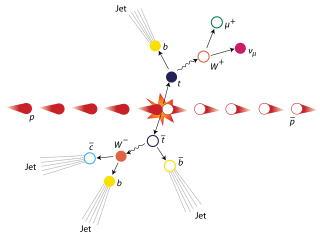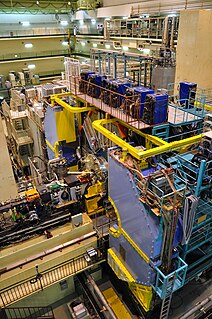Related Research Articles
In particle physics, a hadron is a composite subatomic particle made of two or more quarks held together by the strong interaction. They are analogous to molecules that are held together by the electric force. Most of the mass of ordinary matter comes from two hadrons: the proton and the neutron, while most of the mass of the protons and neutrons is in turn due to the binding energy of their constituent quarks, due to the strong force.

The omega baryons are a family of subatomic hadron particles that are represented by the symbol
Ω
and are either neutral or have a +2, +1 or −1 elementary charge. They are baryons containing no up or down quarks. Omega baryons containing top quarks are not expected to be observed. This is because the Standard Model predicts the mean lifetime of top quarks to be roughly 5×10−25 s, which is about a twentieth of the timescale for strong interactions, and therefore that they do not form hadrons.

The top quark, sometimes also referred to as the truth quark, is the most massive of all observed elementary particles. It derives its mass from its coupling to the Higgs Boson. This coupling is very close to unity; in the Standard Model of particle physics, it is the largest (strongest) coupling at the scale of the weak interactions and above. The top quark was discovered in 1995 by the CDF and DØ experiments at Fermilab.

A pentaquark is a human-made subatomic particle, consisting of four quarks and one antiquark bound together; they are not known to occur naturally, or exist outside of experiments specifically carried out to create them.

A tetraquark, in particle physics, is an exotic meson composed of four valence quarks. A tetraquark state has long been suspected to be allowed by quantum chromodynamics, the modern theory of strong interactions. A tetraquark state is an example of an exotic hadron which lies outside the conventional quark model classification. A number of different types of tetraquark have been observed.

In particle physics, quarkonium is a flavorless meson whose constituents are a heavy quark and its own antiquark, making it both a neutral particle and its own antiparticle.

Two-photon physics, also called gamma–gamma physics, is a branch of particle physics that describes the interactions between two photons. Normally, beams of light pass through each other unperturbed. Inside an optical material, and if the intensity of the beams is high enough, the beams may affect each other through a variety of non-linear effects. In pure vacuum, some weak scattering of light by light exists as well. Also, above some threshold of this center-of-mass energy of the system of the two photons, matter can be created.

Exotic hadrons are subatomic particles composed of quarks and gluons, but which — unlike "well-known" hadrons such as protons, neutrons and mesons — consist of more than three valence quarks. By contrast, "ordinary" hadrons contain just two or three quarks. Hadrons with explicit valence gluon content would also be considered exotic. In theory, there is no limit on the number of quarks in a hadron, as long as the hadron's color charge is white, or color-neutral.

The Belle experiment was a particle physics experiment conducted by the Belle Collaboration, an international collaboration of more than 400 physicists and engineers, at the High Energy Accelerator Research Organisation (KEK) in Tsukuba, Ibaraki Prefecture, Japan. The experiment ran from 1999 to 2010.
CLEO was a general purpose particle detector at the Cornell Electron Storage Ring (CESR), and the name of the collaboration of physicists who operated the detector. The name CLEO is not an acronym; it is short for Cleopatra and was chosen to go with CESR. CESR was a particle accelerator designed to collide electrons and positrons at a center-of-mass energy of approximately 10 GeV. The energy of the accelerator was chosen before the first three bottom quark Upsilon resonances were discovered between 9.4 GeV and 10.4 GeV in 1977. The fourth Υ resonance, the Υ(4S), was slightly above the threshold for, and therefore ideal for the study of, B meson production.
The Xi baryons or cascade particles are a family of subatomic hadron particles which have the symbol Ξ and may have an electric charge of +2 e, +1 e, 0, or −1 e, where e is the elementary charge.
The
B
s meson is a meson composed of a bottom antiquark and a strange quark. Its antiparticle is the
B
s meson, composed of a bottom quark and a strange antiquark.
The timeline of particle physics lists the sequence of particle physics theories and discoveries in chronological order. The most modern developments follow the scientific development of the discipline of particle physics.
Z(4430) is a mesonic resonance discovered by the Belle experiment. It has a mass of 4430 MeV/c2. The resonant nature of the peak has been confirmed by the LHCb experiment with a significance of at least 13.9 σ. The particle is charged and is thought to have a quark content of
c
c
d
u
, making it a tetraquark candidate. It has the spin-parity quantum numbers JP = 1+.
In particle physics, B mesons are mesons composed of a bottom antiquark and either an up, down, strange or charm quark. The combination of a bottom antiquark and a top quark is not thought to be possible because of the top quark's short lifetime. The combination of a bottom antiquark and a bottom quark is not a B meson, but rather bottomonium, which is something else entirely.

In particle physics, CP violation is a violation of CP-symmetry : the combination of C-symmetry and P-symmetry. CP-symmetry states that the laws of physics should be the same if a particle is interchanged with its antiparticle (C-symmetry) while its spatial coordinates are inverted. The discovery of CP violation in 1964 in the decays of neutral kaons resulted in the Nobel Prize in Physics in 1980 for its discoverers James Cronin and Val Fitch.
The Y(4140) particle is an electrically neutral exotic hadron candidate that is about 4.4 times heavier than the proton. It was observed at Fermilab and announced on 17 March 2009. This particle is extremely rare and was detected in only 20 of billions of collisions.

Modern searches for Lorentz violation are scientific studies that look for deviations from Lorentz invariance or symmetry, a set of fundamental frameworks that underpin modern science and fundamental physics in particular. These studies try to determine whether violations or exceptions might exist for well-known physical laws such as special relativity and CPT symmetry, as predicted by some variations of quantum gravity, string theory, and some alternatives to general relativity.
The Zc(3900) is a hadron, a type of subatomic particle made of quarks, believed to be the first tetraquark that has been observed experimentally. The discovery was made in 2013 by two independent research groups: one using the BES III detector at the Chinese Beijing Electron Positron Collider, the other being part of the Belle experiment group at the Japanese KEK particle physics laboratory.
SooKyung Choi is a South Korean particle physicist at Gyeongsang National University. She is part of the Belle experiment and was the first to observe the X(3872) meson in 2003. She won the 2017 Ho-Am Prize in Science.
References
- David Harris (13 April 2008). "The charming case of X(3872)". Symmetry Magazine. Retrieved 2009-12-17.